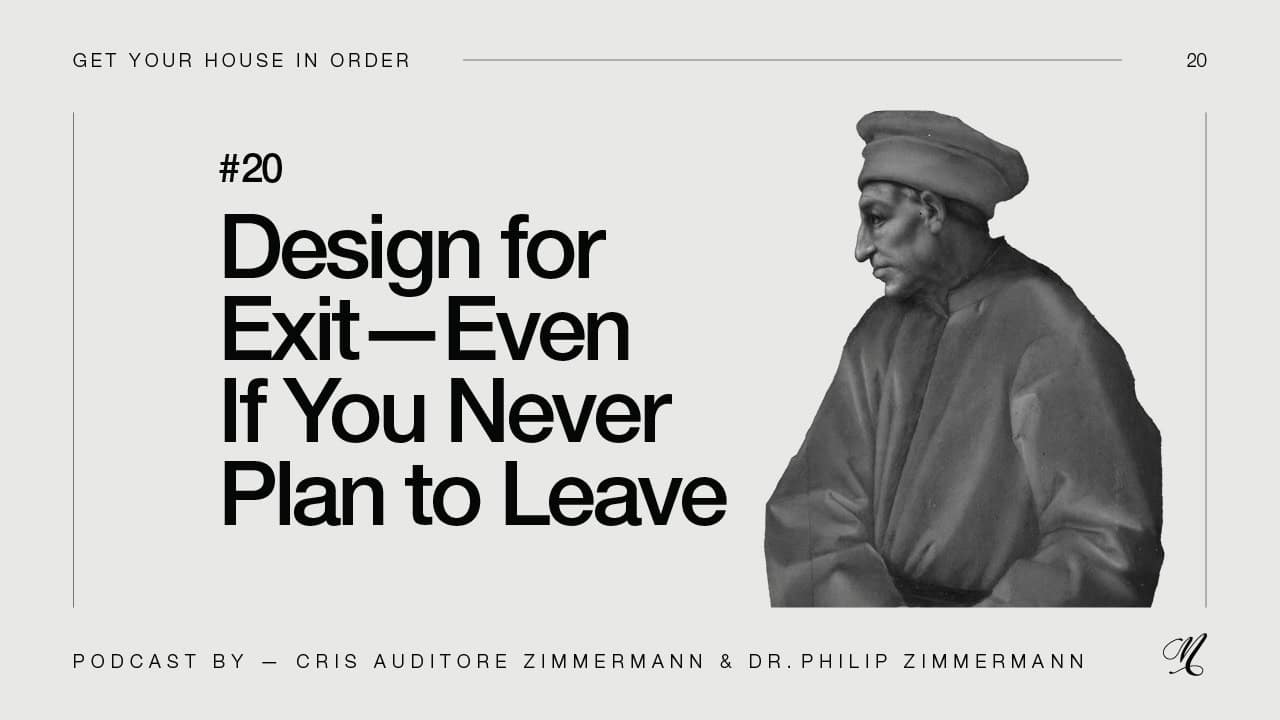[Podcast Episode #20] Design for Exit—Even If You Never Plan to Leave

Episode #20
Most business owners dream of selling their company, but the reality is that many small businesses cannot be sold because they’re too dependent on the owner. Creating a self-managing business that can operate without you is essential whether you plan to exit or not.
In this episode Cris & Philip tackle the crucial concept of “Design for Exit,” revealing why every entrepreneur should structure their business as if they might sell it tomorrow, even if they plan to run it forever.
Some topics covered are:
- Business That Can’t Run Without You = Job
- Shift from Superstar to Coach
- Legal Docs & Contracts Make Business Sellable
- Consultants Help Prepare for Exit
- Systematic Marketing & Sales Build Self-Managing Business
- Build to Sell for Peace of Mind
- Time & Resource Freedom Enables Multiple Pursuits
- Self-Managing Business Reduces Stress & Builds Legacy
- And more…
Episode Summary
The concept of “Design for Exit” is a powerful framework that every business owner should embrace, even if they have no immediate plans to sell their company. At its core, this mindset forces entrepreneurs to build self-managing businesses that can thrive without their constant involvement. Cris and Philip, recently discussed this essential principle and why it matters to entrepreneurs at every stage of their journey.
Many business owners dream of selling their companies for millions, but the sobering reality is that most small businesses simply aren’t sellable. Why? Because they’re too dependent on the owner. As Cris shared in a recent conversation with a frustrated business owner who wanted to sell his million-euro revenue company with €250,000 in net profit: “It’s not sellable because it’s so tied into your personality, your work, and your relationships. If I take you out of the equation, there’s no business.” This scenario plays out repeatedly across industries—businesses that generate solid revenue but remain fundamentally unsellable because they’re built around the owner’s personal connections, expertise, and daily involvement.
The distinction between having a business and having a job is critical. If you can’t leave your company for a few weeks without operations deteriorating, you don’t truly own a business—the business owns you. You’ve created a job for yourself, not an asset that can be transferred, sold, or passed down. Building a self-managing business requires developing systems, processes, and teams that can function effectively without the founder’s daily involvement. This structural shift transforms your role from being the star player (the one making all the goals) to becoming the coach who empowers others to perform at their highest level.
This transition isn’t merely about documentation or hiring the right people; it requires a fundamental identity shift. Many entrepreneurs build their businesses around their personal expertise and relationships. Their identity becomes intertwined with being the superstar—the Ronaldo or Messi of their organization. The critical shift happens when they step back and empower others to take center stage, focusing instead on strategy and leadership rather than day-to-day operations. This identity transformation is often the most challenging aspect of designing for exit, requiring business owners to derive satisfaction from others’ successes rather than their own spotlight moments.
Even for those who never intend to sell, designing for exit offers tremendous benefits. It creates freedom to pursue new ventures, causes, or simply enjoy life outside of work. As Philip noted, “If you don’t want to manage, you can put in a manager because you’ve set it up in a way that he or she can still run it. You can be part of the strategic decisions, but you actually have time to think, reflect, network, learn, and study different strategies.” This freedom allows entrepreneurs to explore their full potential, whether that means launching new businesses, pursuing philanthropic interests, or simply having more time with family.
The foundation of a self-managing business starts with robust marketing and sales systems that consistently generate leads and convert them into customers without requiring the owner’s constant involvement. Without this foundation, no amount of operational efficiency can create true freedom. Creating these systematic approaches to revenue generation provides the cash flow necessary to hire talent and build infrastructure that further reduces owner dependency.
Whether your goal is to sell for millions, pass your business to the next generation, or simply enjoy more freedom while continuing to own your company, designing for exit provides a pathway to creating both a beautiful business and a beautiful life. It transforms stress into peace, constraint into possibility, and work into legacy.
If you are interested in learning more about designing a self-managing business, visit selfmanagingbusiness.info.

Get a free copy of "Get Your House in Order"
Principles of success based on the life of Cosimo de’ Medici by Cris Auditore Zimmermann
